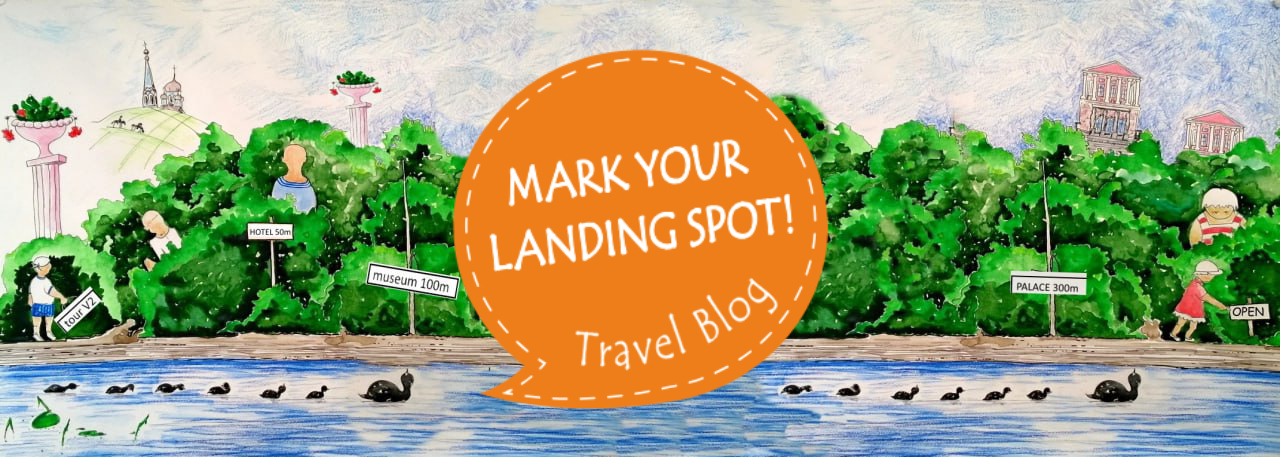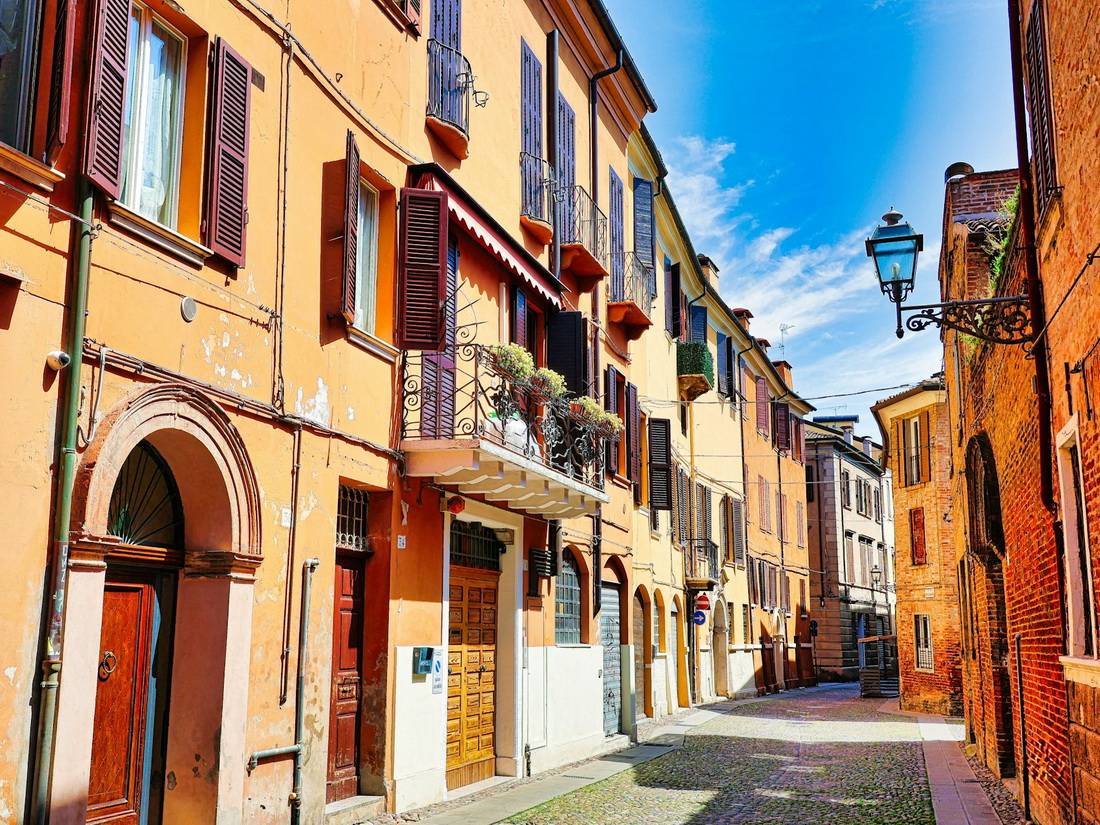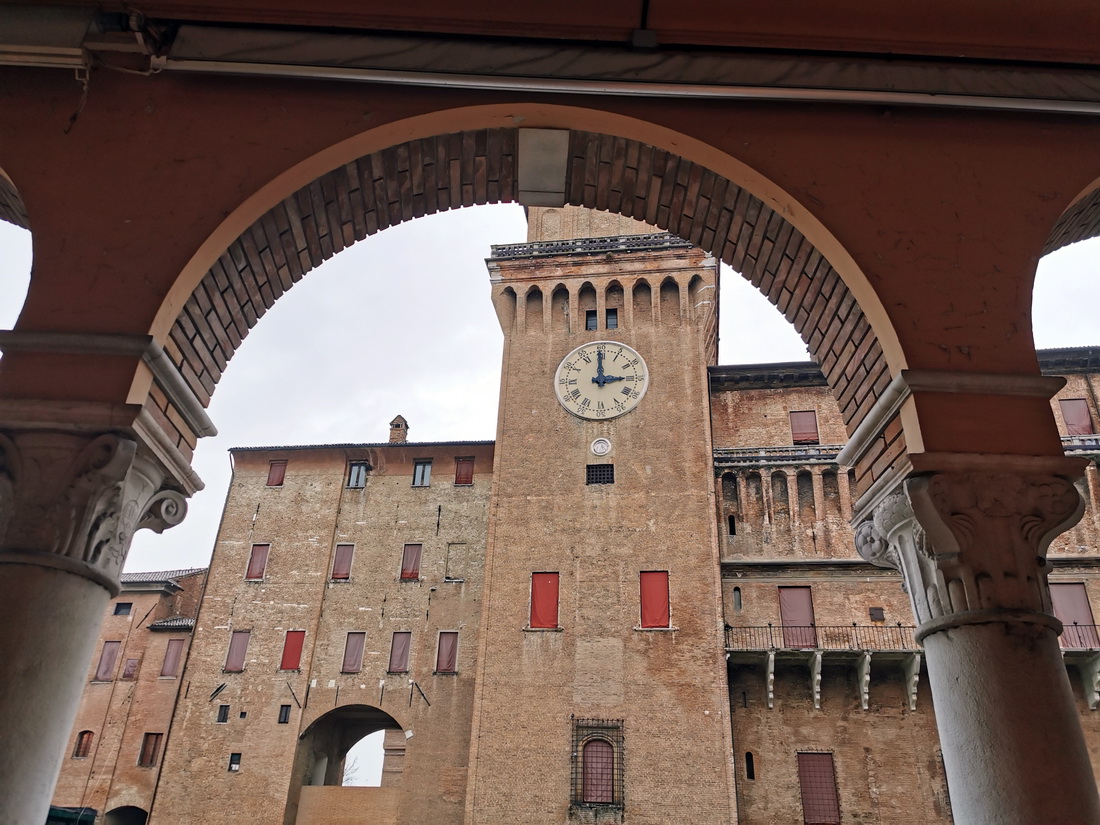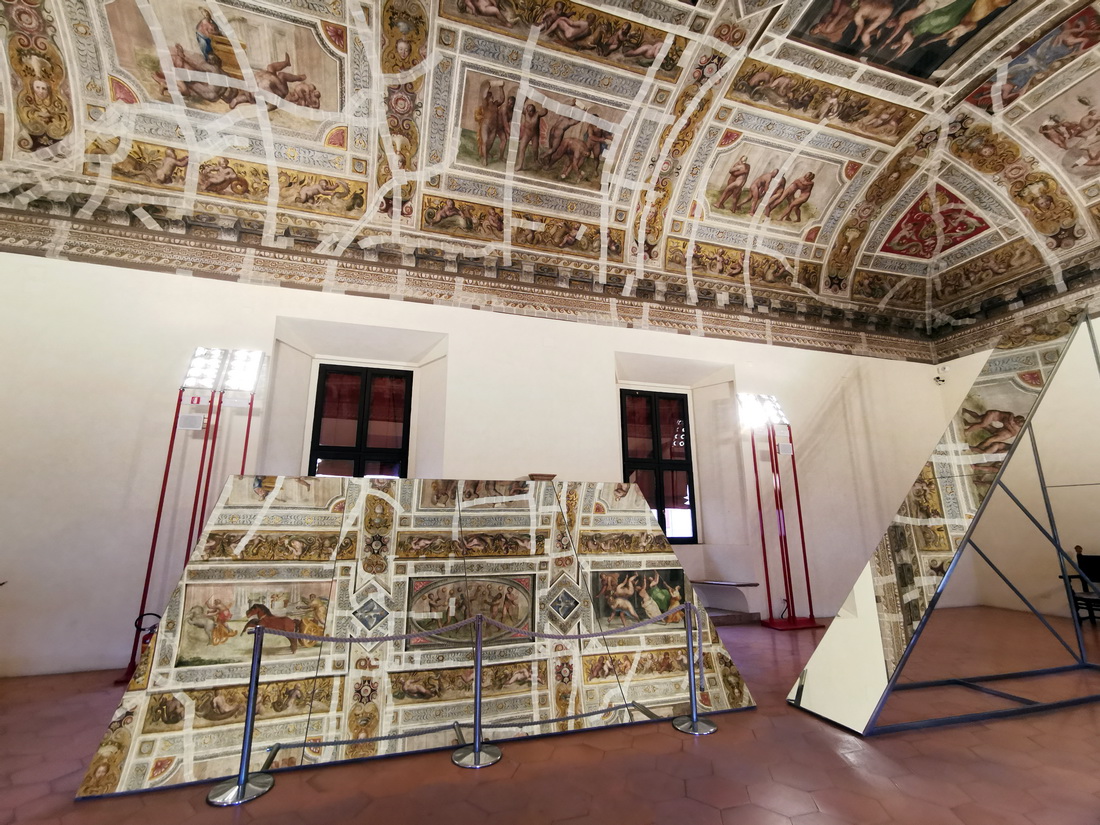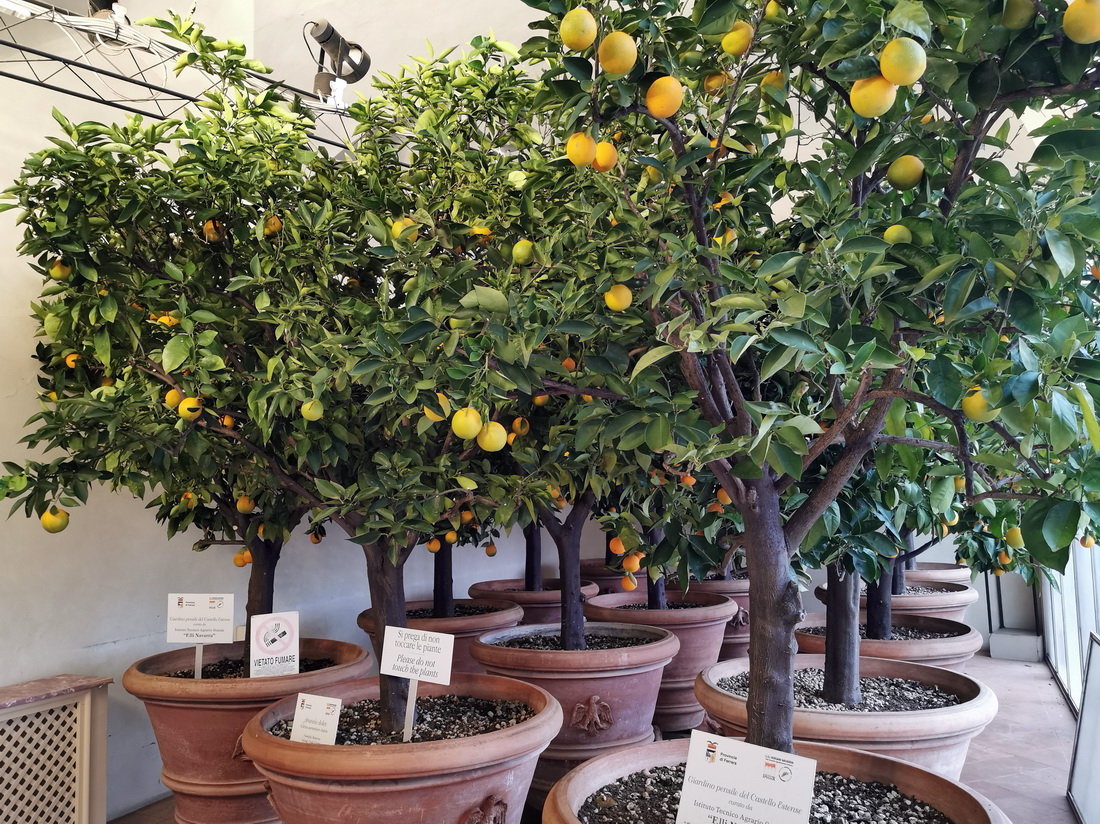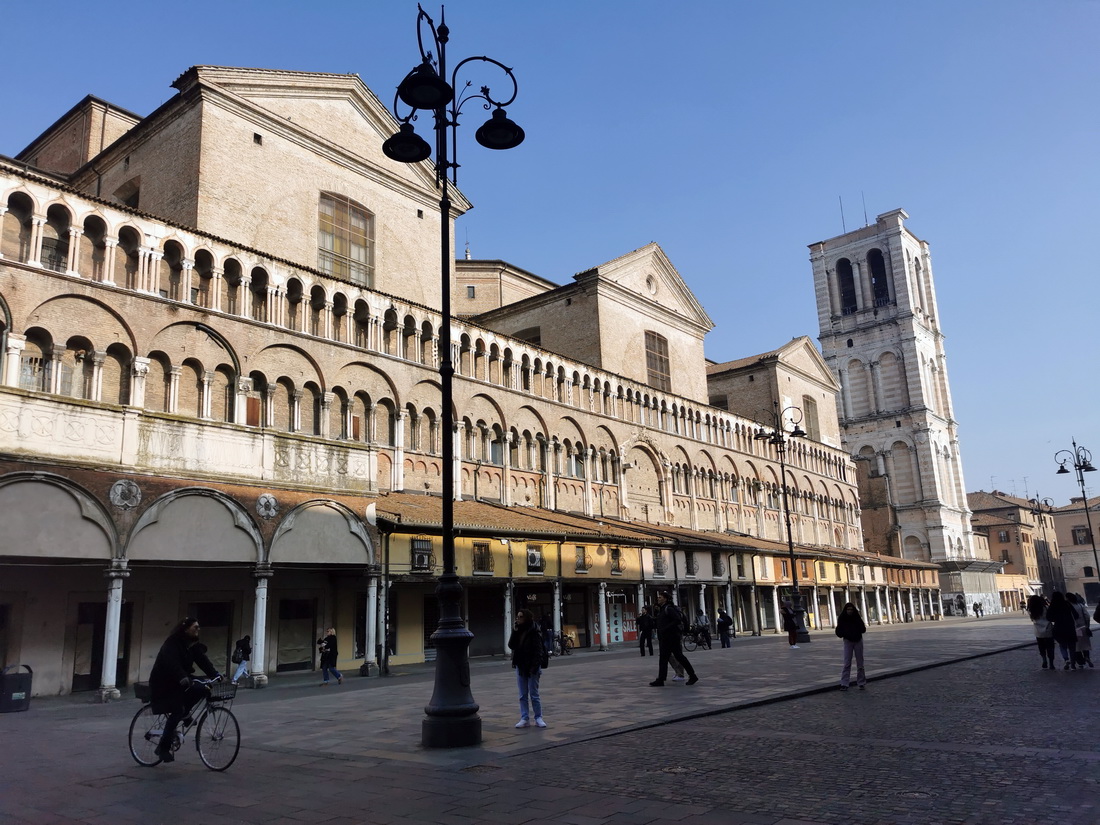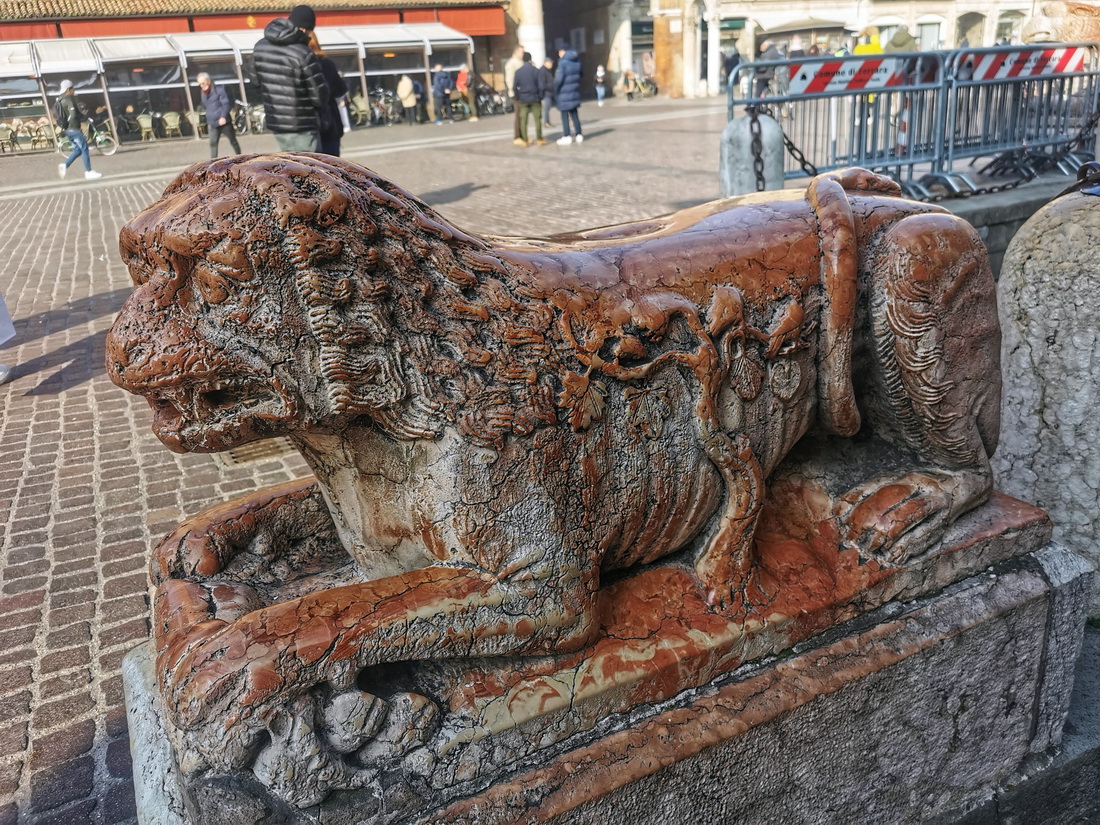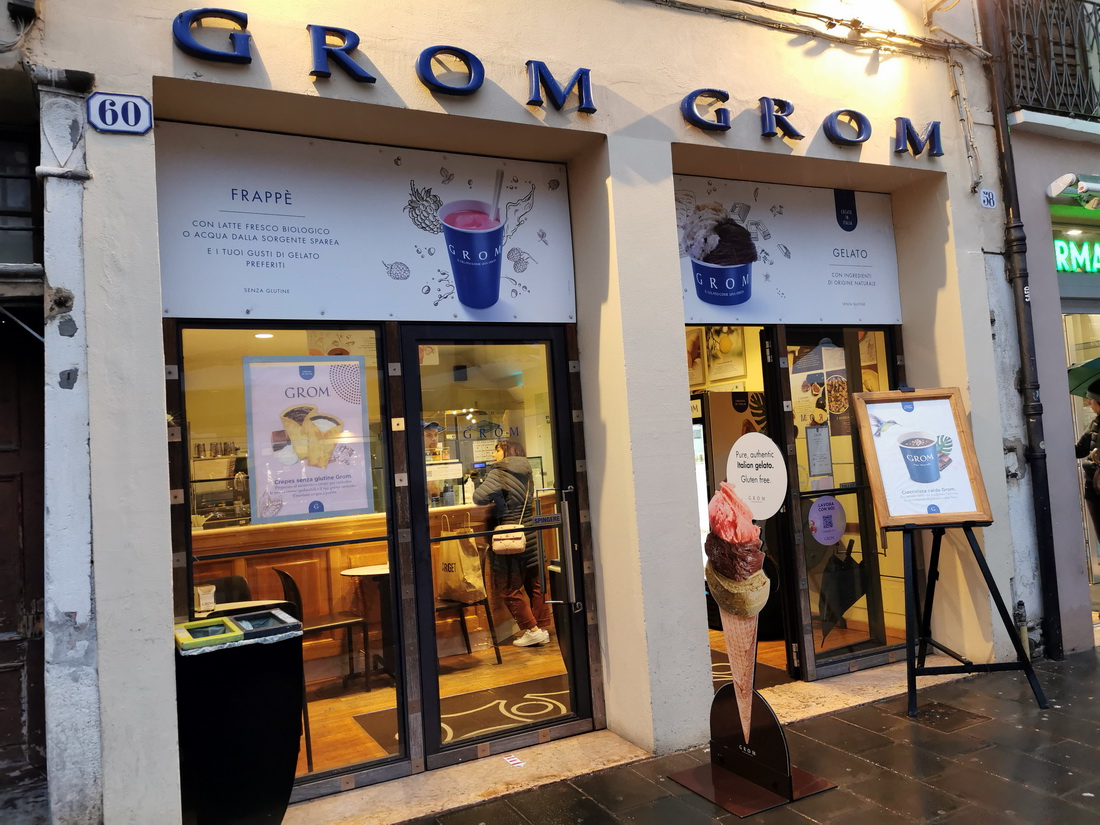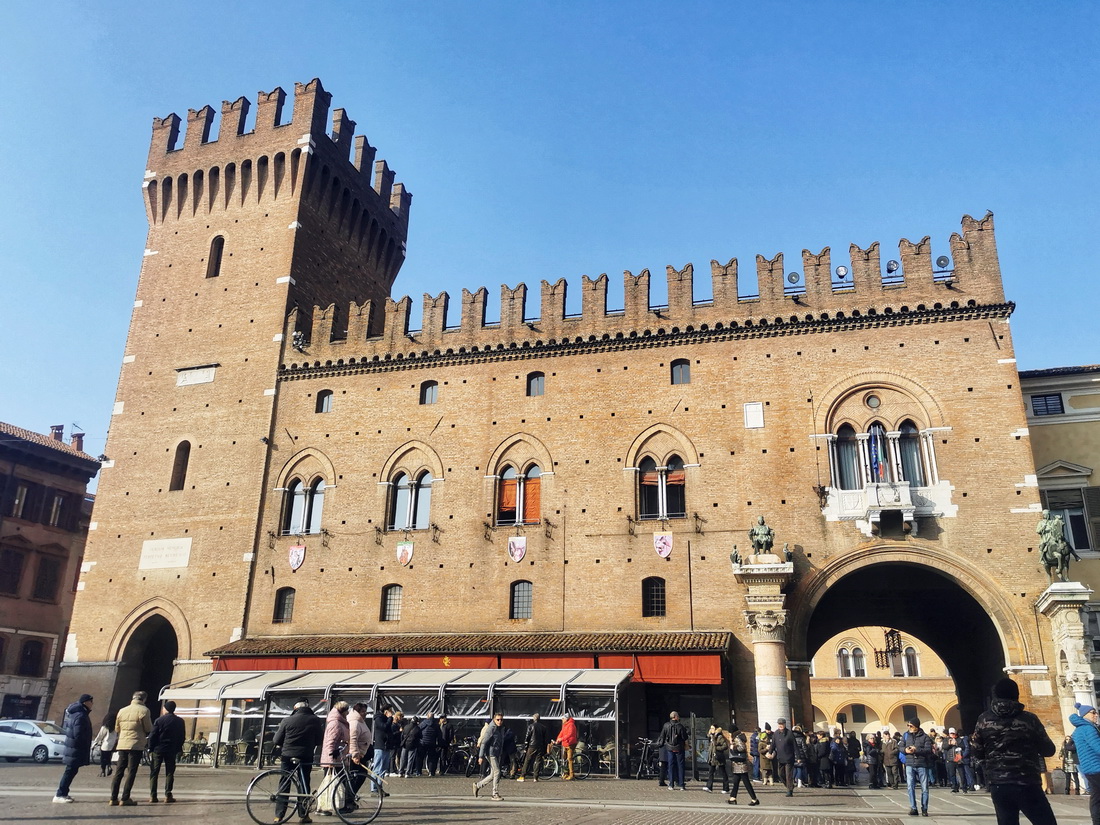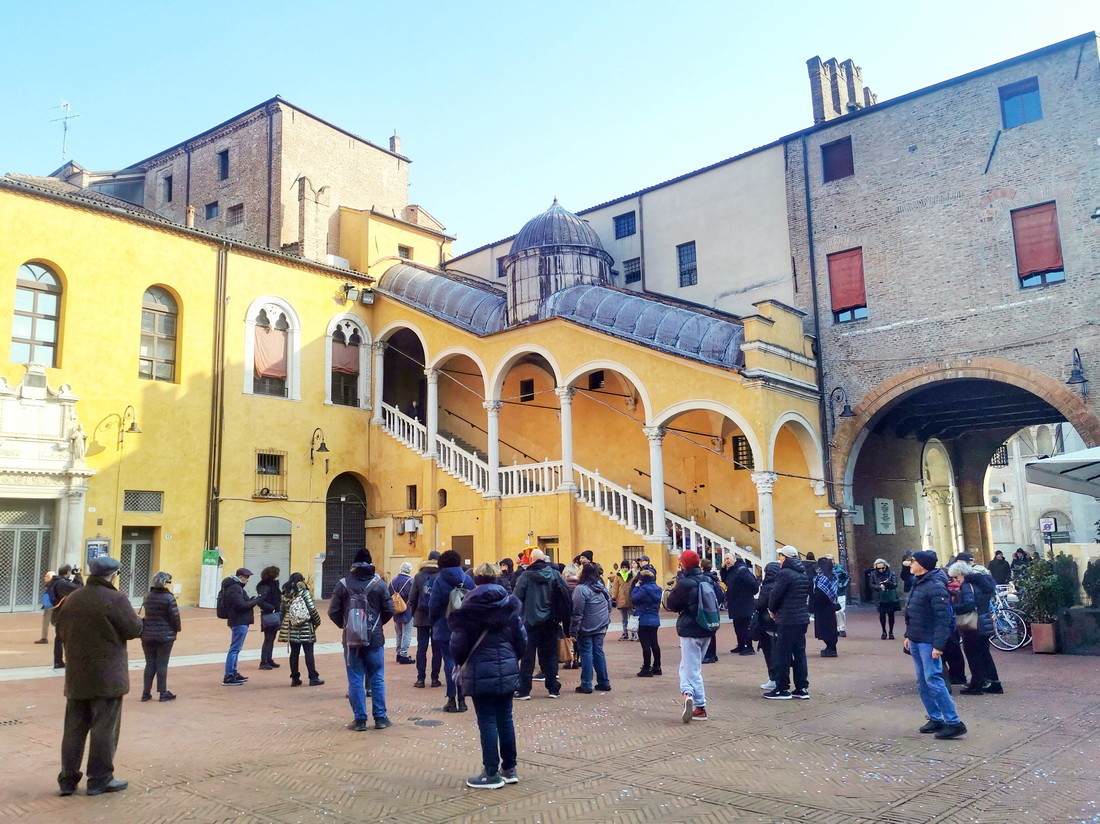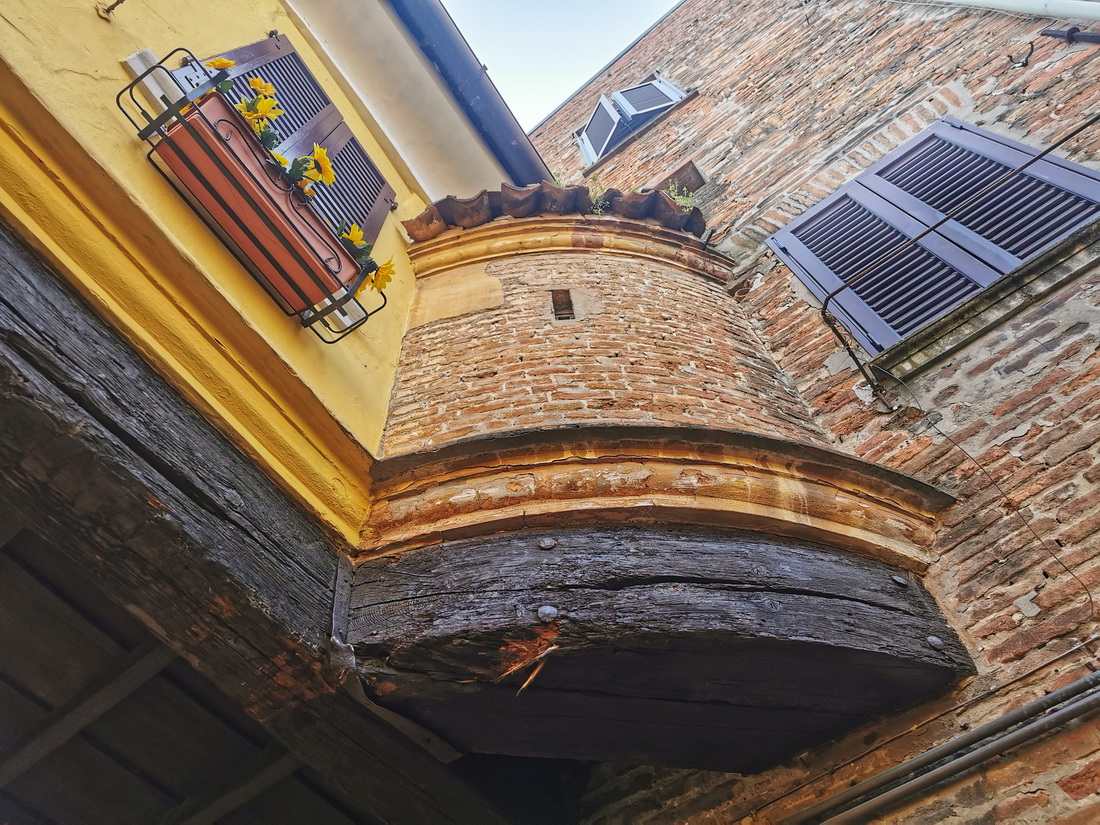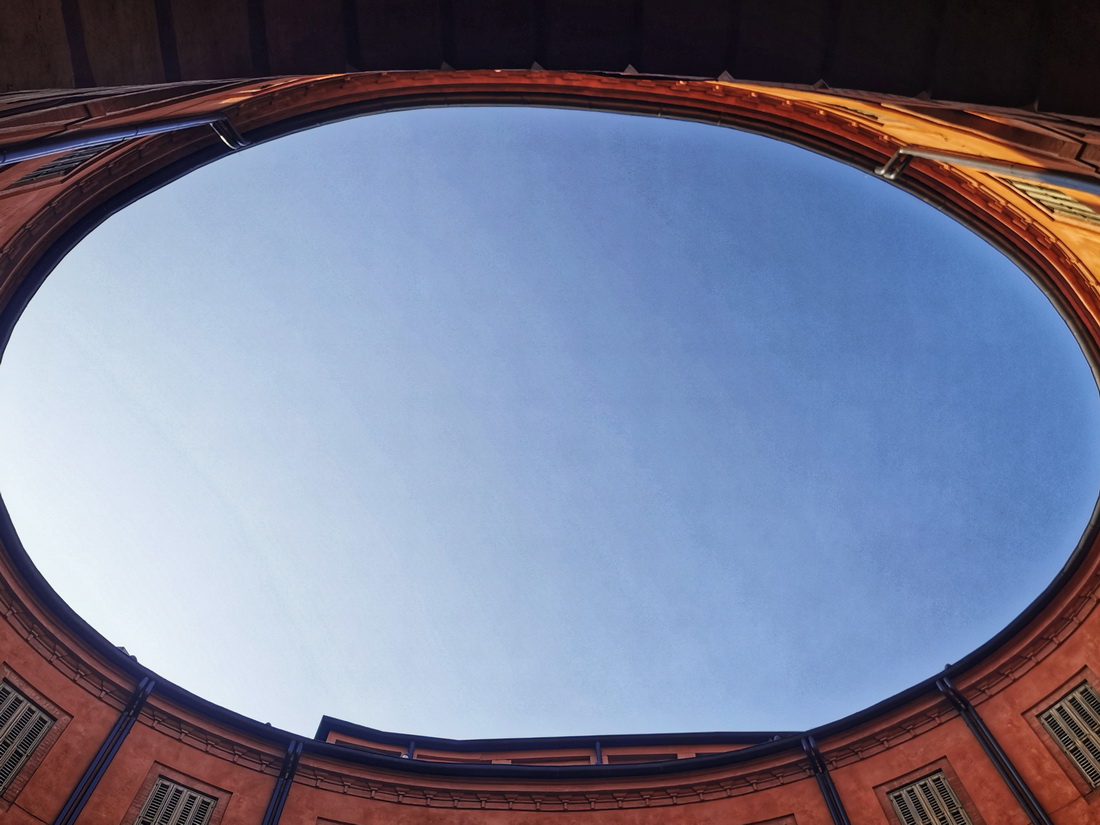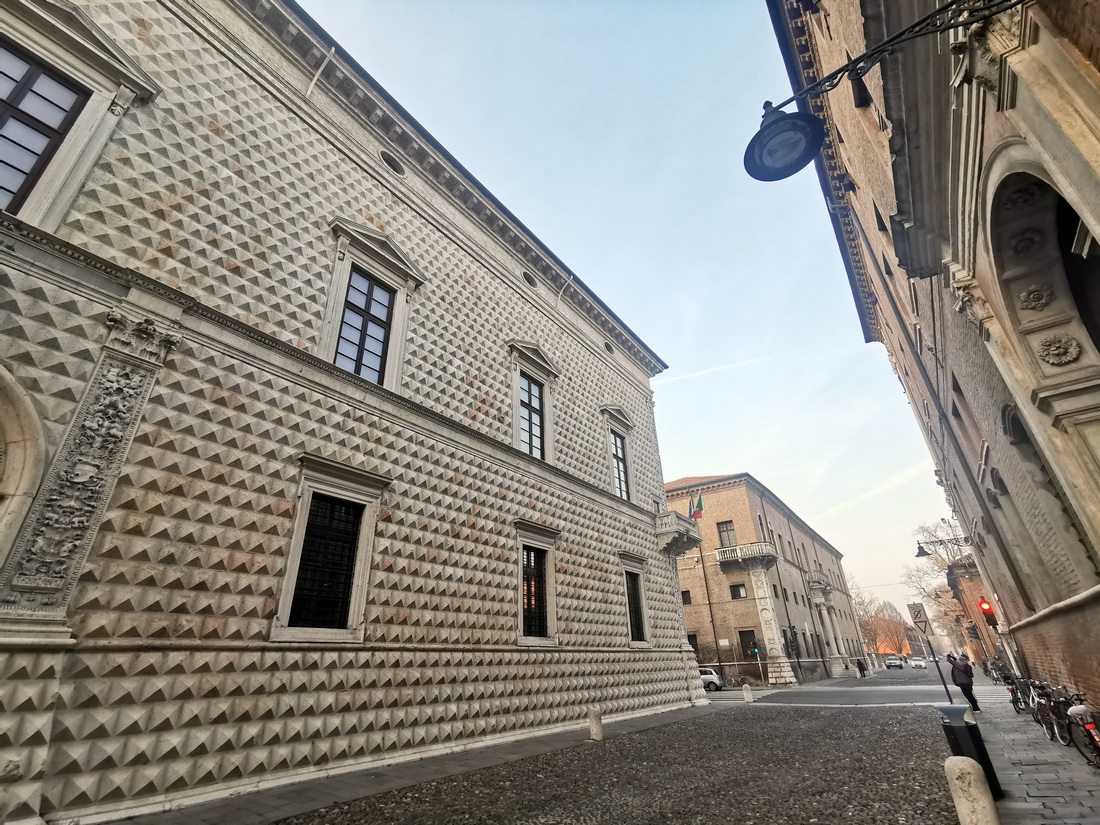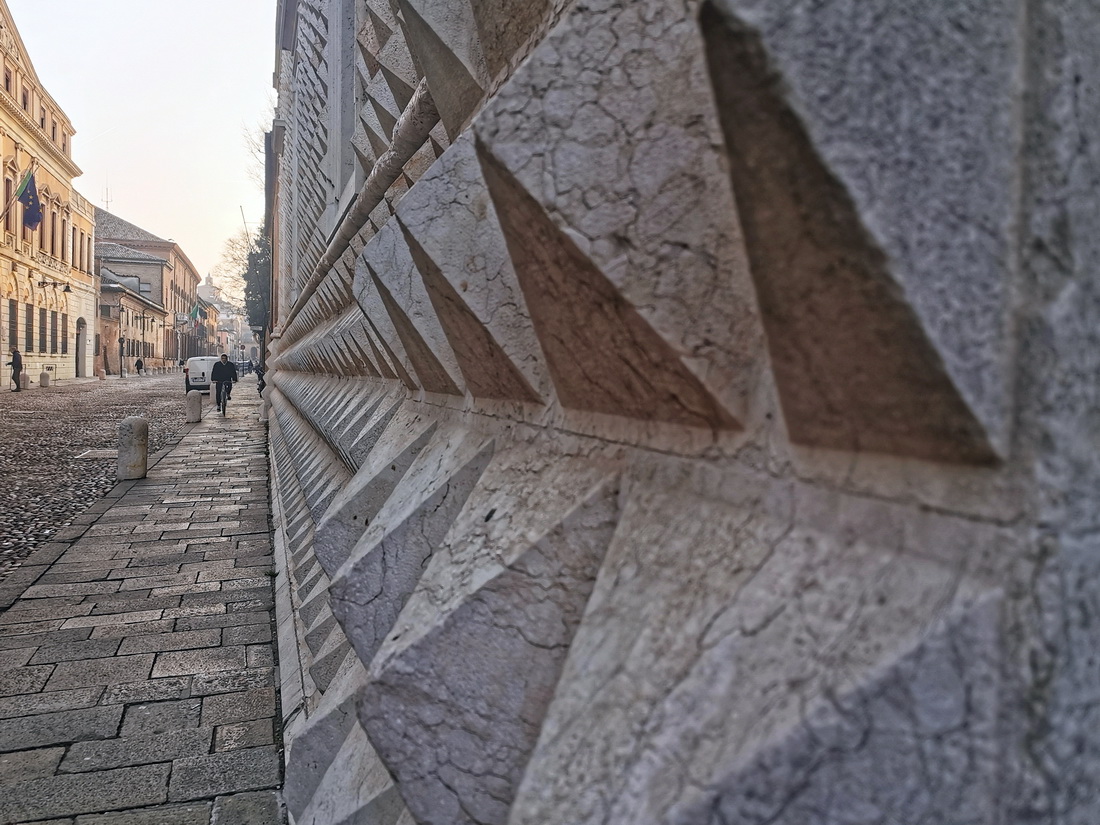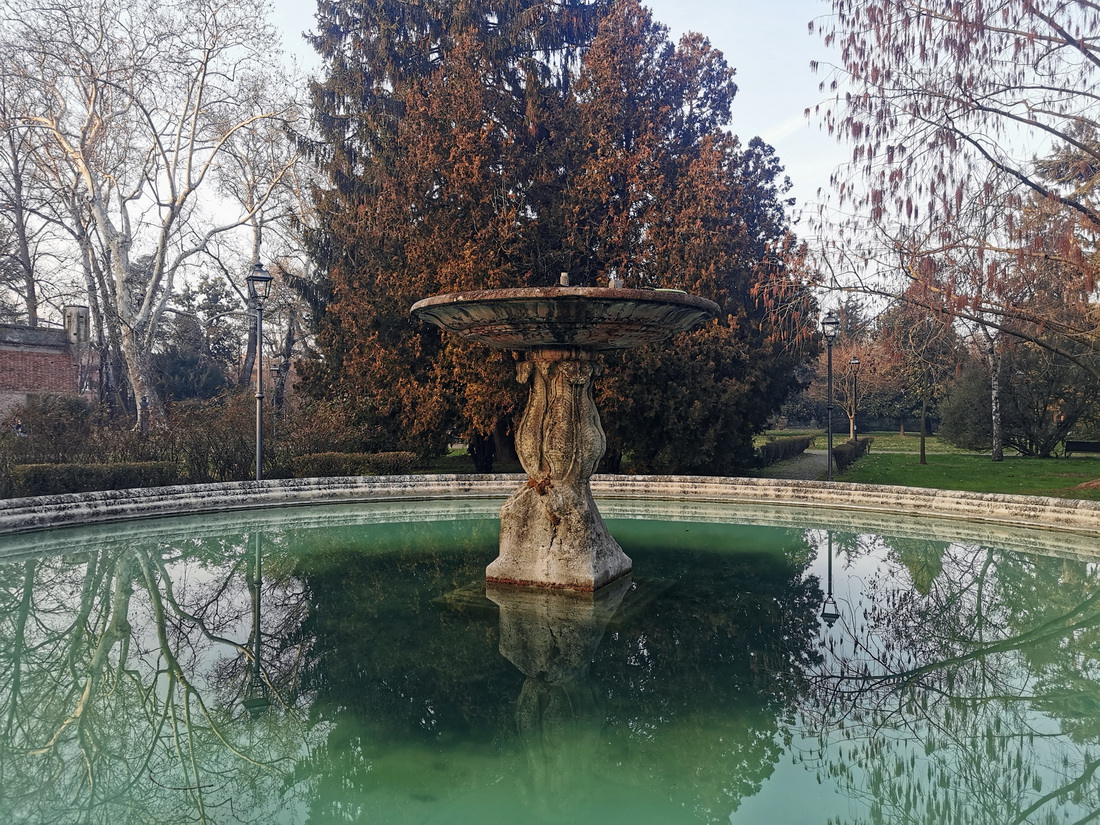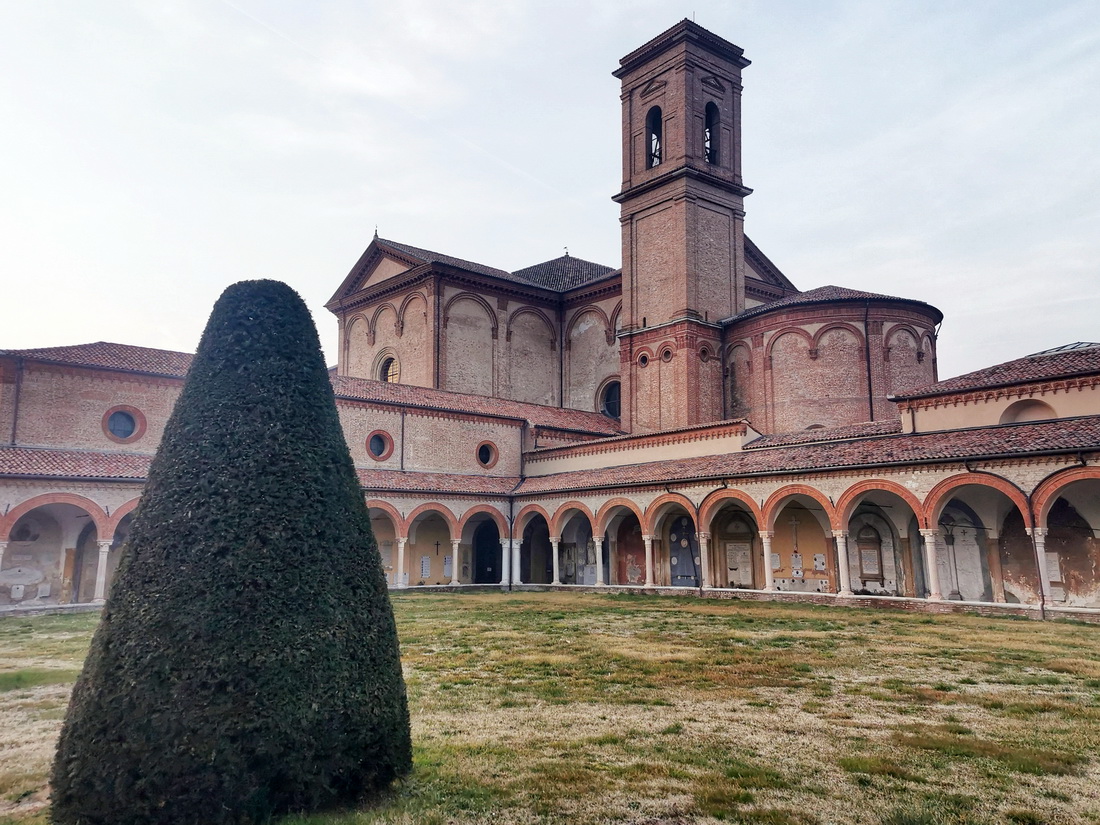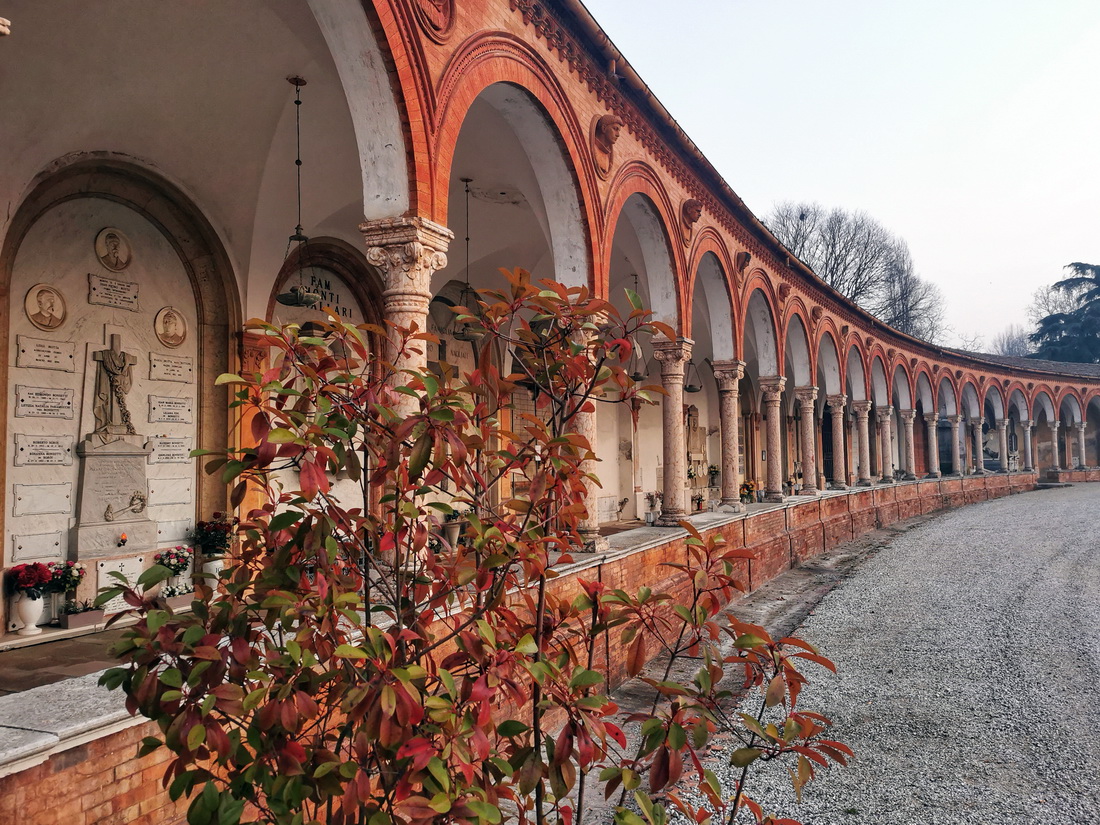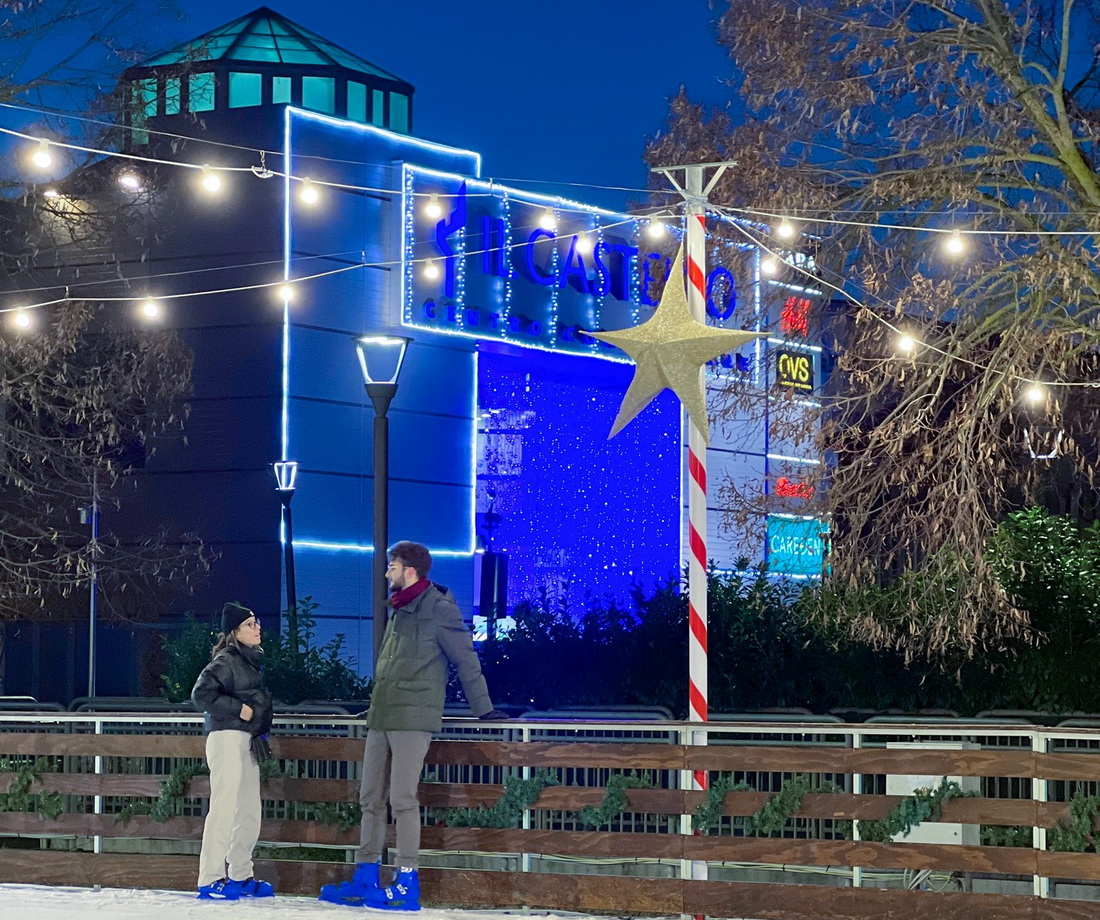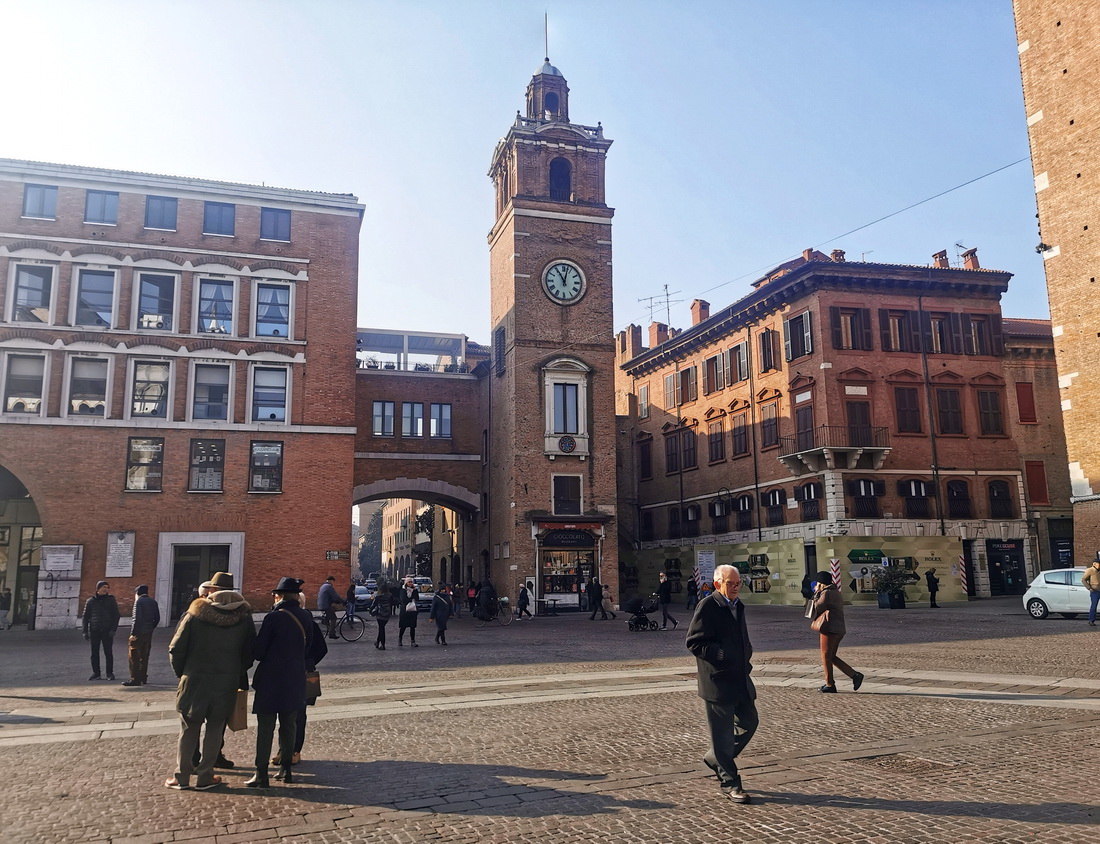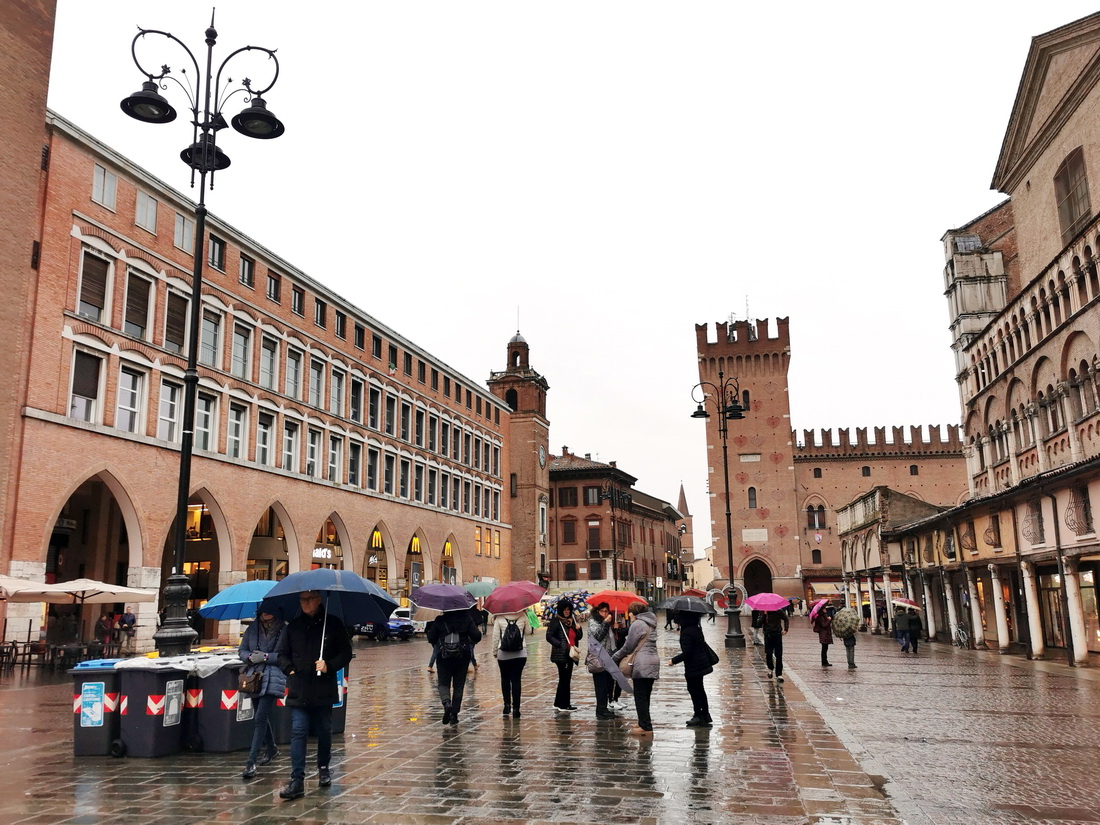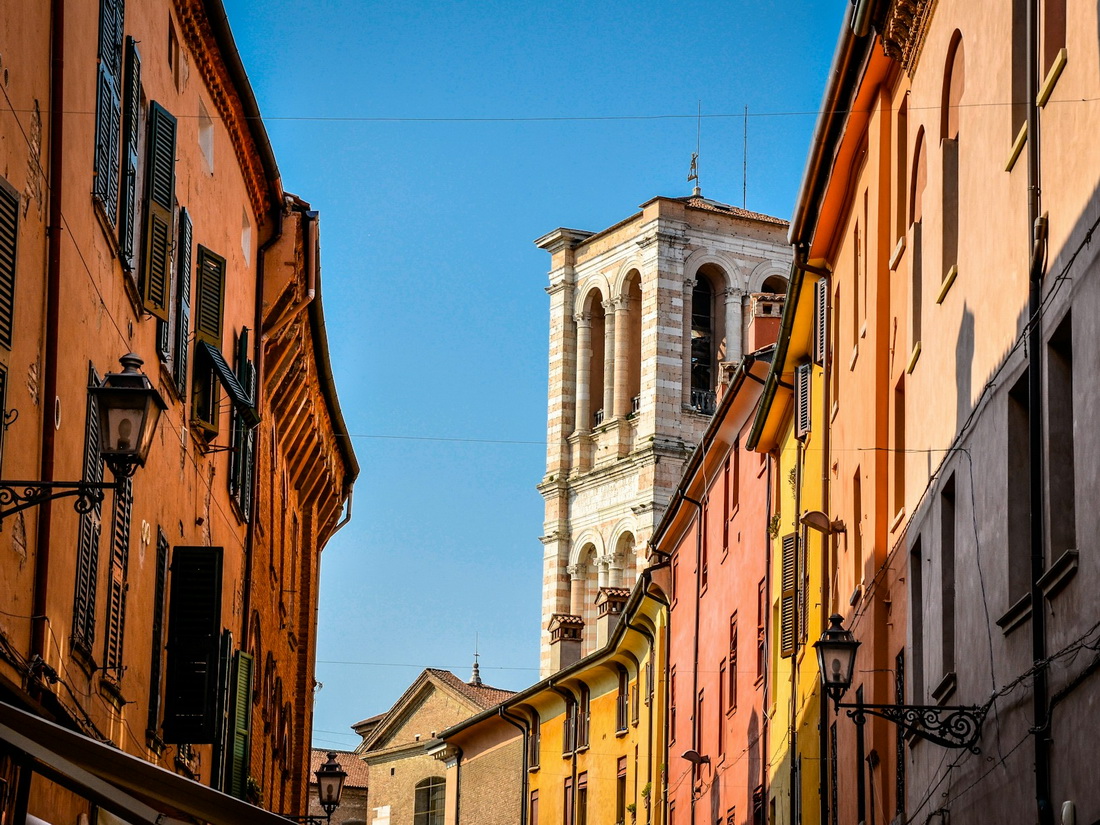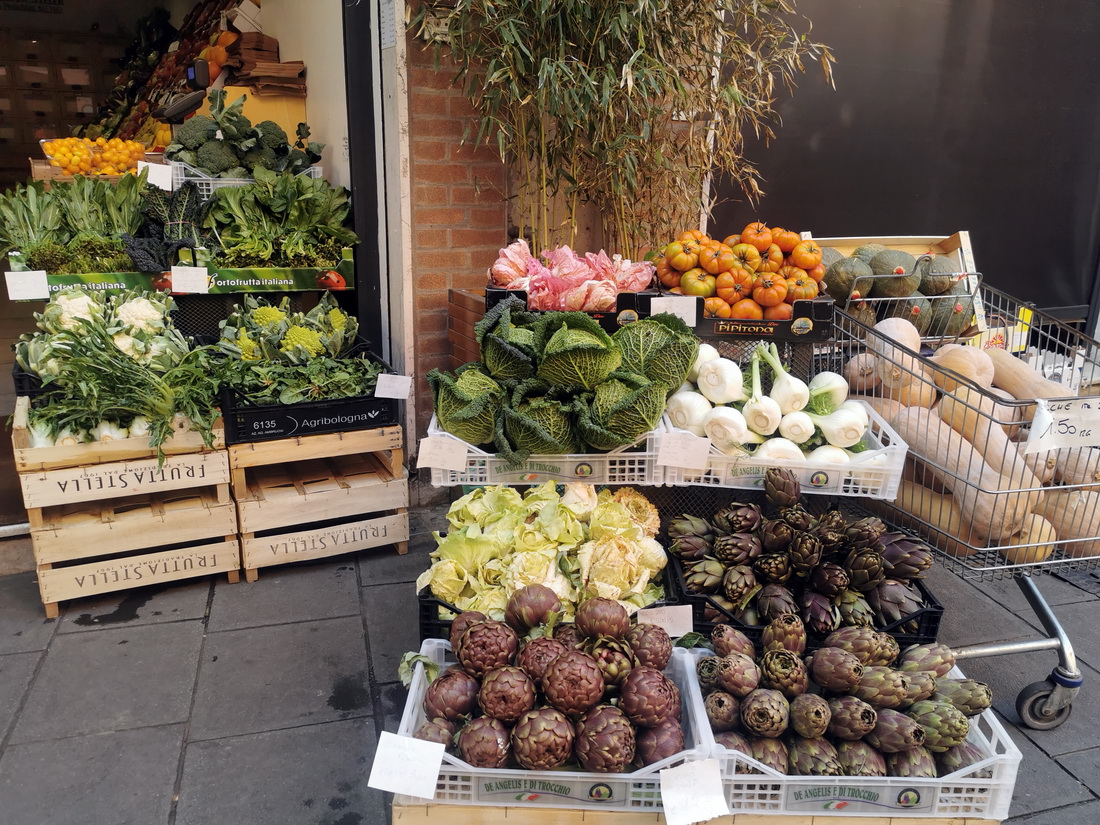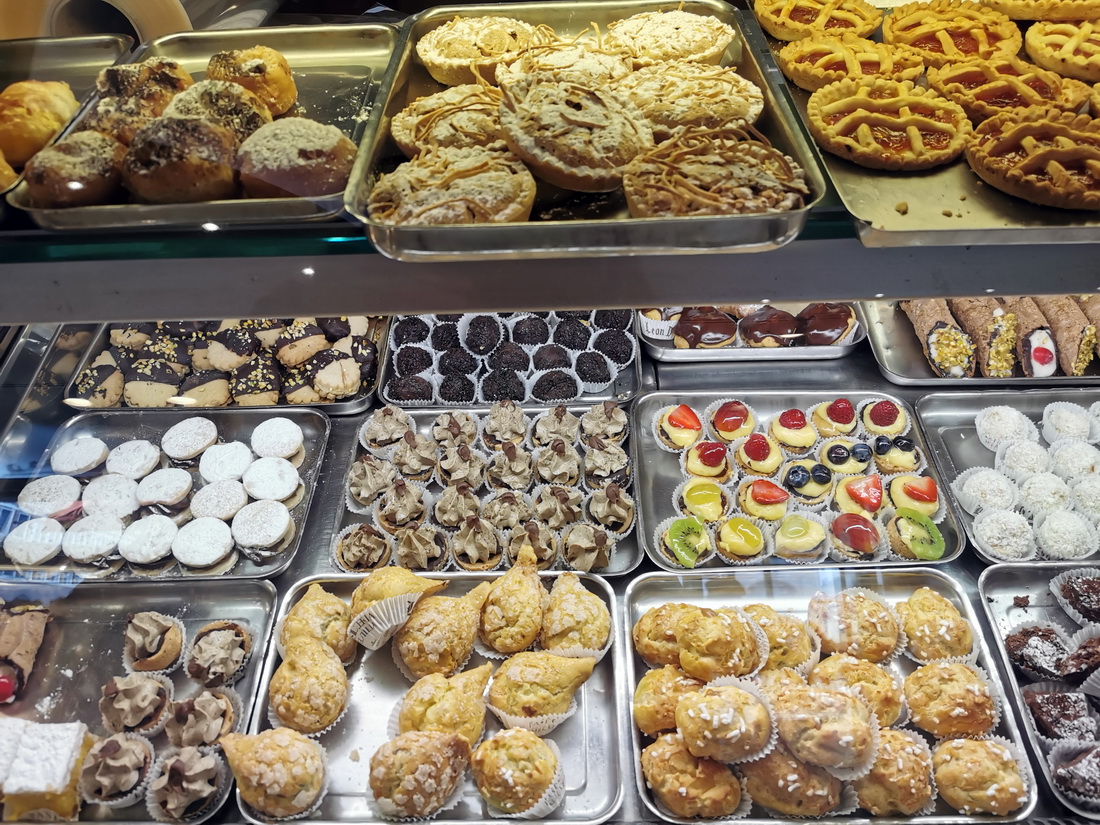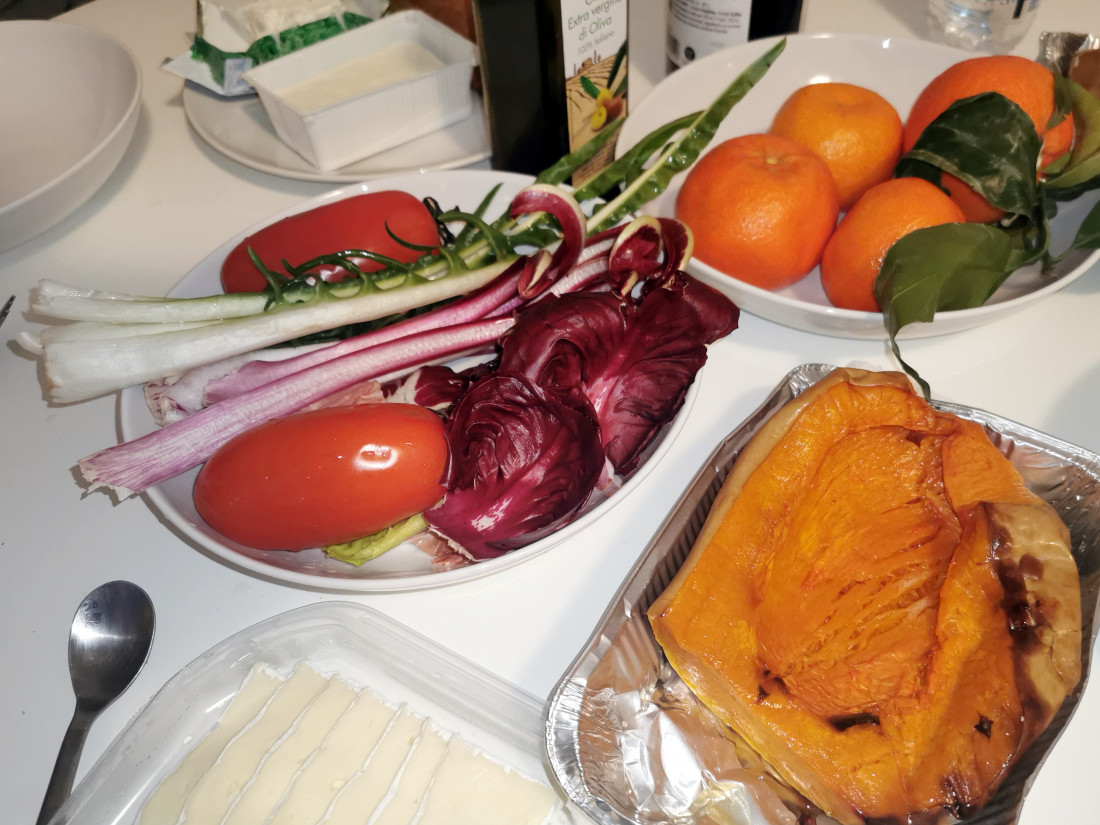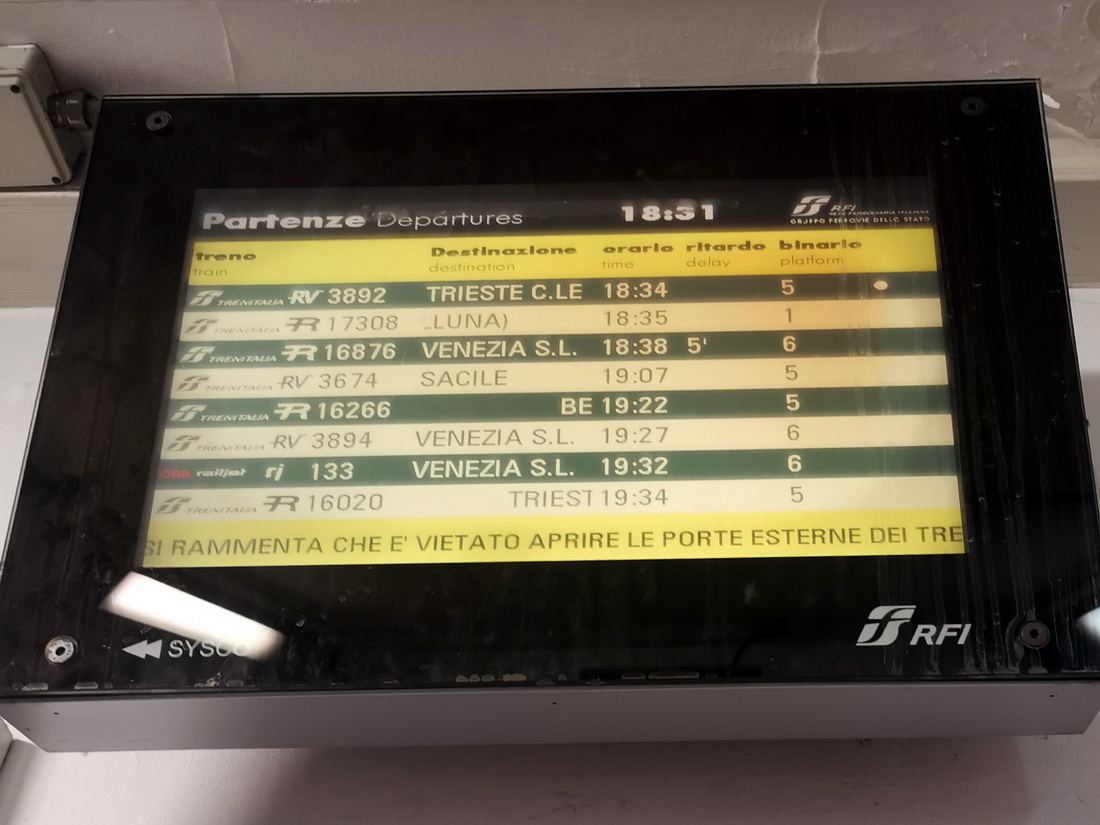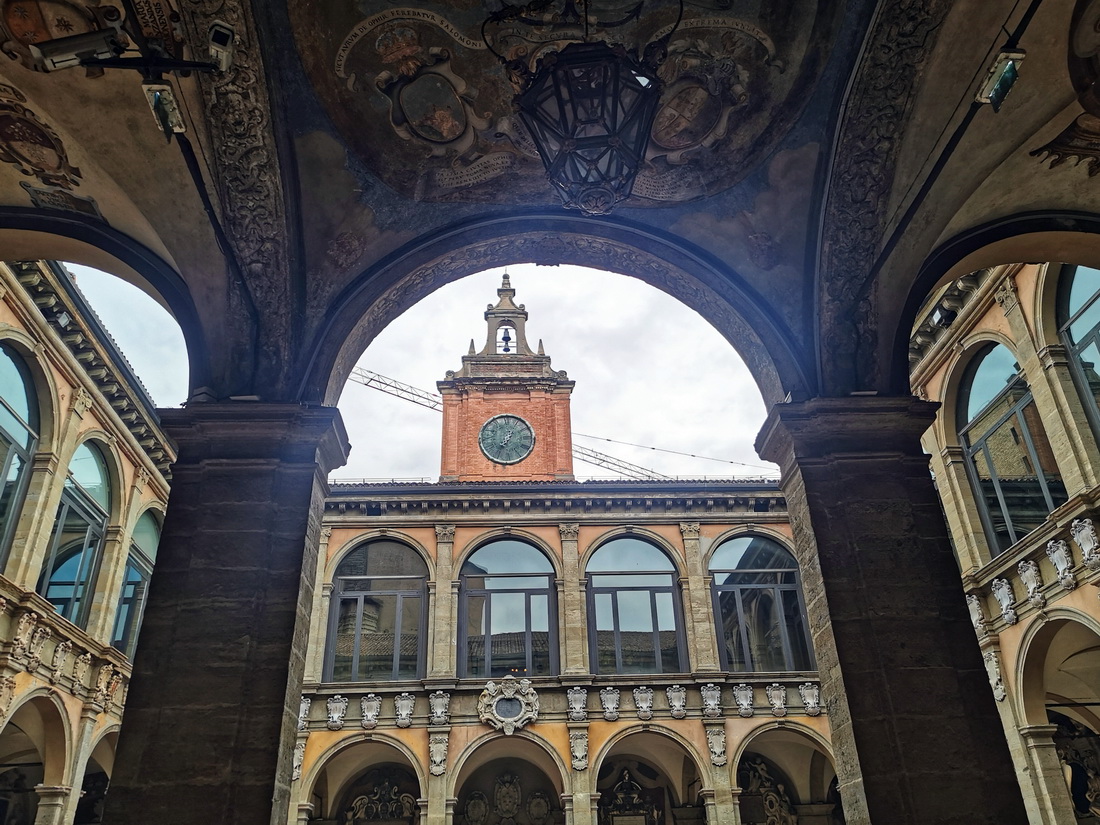I first picked Ferrara as a base for its train links, but it quickly proved to be more than practical. The city feels lived in, not staged: quiet streets, palaces with people still inside them, locals who don’t treat you like a tourist. It’s the only place on my trip where I felt I could simply breathe.
In brief:
- Population: 132,000 — just the right size
- History: Once rivaled Venice and Milan in art, ambition, and influence
- UNESCO: The entire old town is protected, not just a token cathedral
Ferrara is flat and compact — a 20-minute walk from the station to the castle, or a quick bus if you’ve overpacked (or bought half a wheel of Parmesan). Bikes are part of the scene, but not the whole story. Prices are friendly too: coffee for about €1.30, generous dinners without the sting, and central apartments that don’t wreck your budget. Compared to its tourist-heavy neighbours, Ferrara still feels like a well-kept secret.
Before we get to the practicalities — when to come, where to stay, how to get around — let me show you the heart of Ferrara. I walked the city end to end, from its moated castle to the quiet arches of Via delle Volte, and every place I mention here I saw myself. These are the sights that give Ferrara its character, the ones worth slowing down for.
Top Sights and Attractions in Ferrara, Italy (1–2 Days)
1. Estense Castle (Castello Estense)
Right in the heart of the city stands Ferrara’s pride — a red-brick moated castle with four towers, one of the top Ferrara attractions and a must-see for any visitor. Built in 1385 as a fortress for the ruling Este family, it later became their residence — and, remarkably, it still looks much the same as it did in the 16th century.
It’s slightly reminiscent of Milan’s Sforza Castle, but more compact and surrounded by fewer tourists. Inside, you’ll find simple rooms with signs in Italian and English explaining what each one used to be — a kitchen, a prison, a bedroom. There’s not much furniture left, but the painted ceilings are still there, and huge mirrors help you admire them without risking neck strain. A small but genius touch.
You can buy a ticket just for the castle, or go for the combo that includes the Lion Tower — if you’re up for the steep climb.
2. Ferrara Cathedral and Trento – Trieste square
The cathedral, dedicated to Saint George — Ferrara’s patron saint — was built between the 12th and 14th centuries. Its pinkish marble façade mixes Romanesque solidity with Gothic flair, topped off with a later-added bell tower. Stone lions sit by the entrance, keeping a calm, slightly amused watch. When I visited, the interior was closed for restoration, but even from the square it’s one of the essential things to see in Ferrara.
On weekends, the square turns into a proper stage — sometimes literally. One day I saw three local singers performing with such energy they had a small crowd dancing before the first chorus was over. Another time, the stalls were selling tiny cacti and succulents.
Another weekend I stumbled on a sweets market: chocolates, nougat, pastries, honey — a sugar rush in open air. A few treats came home with me as “souvenirs,” though they didn’t last long.
If you haven’t had gelato yet, there’s a Grom right on the square — they use seasonal, natural ingredients. Or head to La Romana on Via Palestro 33 — a bit roomier, with covered gelato bins (which is always a good sign).
Note: the cathedral reopened on 23 March 2024 after long restoration; some works continue.
3. Municipal Palace (Palazzo Municipale)
This was the first residence of the Este dukes — a long, terracotta-colored building with arched windows, a tower, and two bronze statues keeping guard. These days it houses city offices, but the grandeur hasn’t gone anywhere.
Right next to it is Piazza del Municipio — a narrow, rectangular square with arcades, outdoor cafés, and that wonderfully Italian mix of faded elegance and everyday noise. It’s surprisingly tucked away: you enter through an archway and suddenly find yourself in the middle of it all. Like in Bologna or Padua, everything’s pressed close together here — palaces, churches, old family homes. You never walk more than a block without stumbling onto something historic.
4. Volta Street (Via delle Volte)
This narrow, arch-filled street is one of the most atmospheric corners of Ferrara. Walk under one arch, then another, then another — and suddenly you’re not in the 21st century anymore. It’s quiet, slightly shadowy, and full of texture. Less famous than the big landmarks, but easily one of the most memorable Ferrara attractions.
The street runs parallel to the main one and is just a short stroll from the cathedral. Parts of it have been beautifully restored, with river pebbles underfoot — uneven, but very medieval. Some buildings lean a little, others are patched with different materials, but that only adds to the charm.
5. La Rotonda Foschini
One of the first places I stumbled into in Ferrara — suitcase in tow, fresh off the train — was this glowing circular courtyard. At first I wasn’t even sure what it was, but it looked magical.
La Rotonda Foschini is the inner courtyard of Ferrara’s 18th-century Communal Theater, opened in 1798 and beautifully restored in recent years. The soft lighting, curved walls, and perfect symmetry make it feel like a hidden stage. Even if you’re just passing through, it’s worth pausing for a minute, standing still, and looking up.
6. Diamond Palace (Palazzo dei Diamanti)
Just a ten-minute walk north of the castle stands one of Ferrara’s most eye-catching buildings — Palazzo dei Diamanti. Its facade is covered with thousands of pale stone blocks carved into pyramids, catching the light in different ways as you walk past.
Inside is the Pinacoteca Nazionale, with works by Garofalo, Filippi, Dossi, and Mantegna. You enter through a quiet courtyard, and a staircase tucked in the corner takes you up to the gallery.
7. Massari Park
Massari Park isn’t about grand sights — and that’s exactly its charm. It’s a peaceful green space between Palazzo dei Diamanti and the Certosa, where you can stretch your legs, sit by a fountain, or just breathe under massive trees. Lebanese cedars, plane trees, oaks, chestnuts — the kind of trees that know how to throw shade, in the best possible way.
In summer, this place is a gift. And yes, there’s even a free public restroom — not beautiful, but there when you need it.
8. Botanical Garden (Orto Botanico di Ferrara)
Tucked between the Diamond Palace and Massari Park is a small botanical garden — not the most polished, but full of quiet charm. In February, there’s not much going on, but come spring or summer, it’s a lovely spot to wander for a bit of green.
The garden has around 700 plant species, spread across outdoor beds and greenhouses. There’s a pond with aquatic plants, a few carnivorous specimens, some graceful bald cypress, and a surprising variety of maples. It’s not dramatic, but if you like gardens, this one’s worth a slow lap.
Admission is free; weekdays 9:00–13:00 are the safe bet.
9. Certosa di Ferrara
Originally founded in 1452 as a Carthusian monastery and expanded later in the 15th century, the Certosa is now one of Ferrara’s most unexpected and peaceful places — part cemetery, part quiet sculpture garden. It’s about a 15-minute walk from the castle, and well worth the detour. If you’re looking for unusual Ferrara sights beyond the centre, the Certosa is hard to beat.
The monastic life here ended in 1813, when the complex became municipal property and was transformed into a monumental cemetery. Many of the tombs are surprisingly varied — some grand and theatrical, others small and deeply personal. Angels, weeping figures, inscriptions, even entire family scenes carved in stone — walking through it feels like leafing through a very still, very beautiful storybook.
10. Il Castello Centro Commerciale
If you’re in need of groceries, a new frying pan, or just a break from Renaissance architecture, Ferrara’s biggest shopping center — Il Castello — is out on Via Giusti 4. It’s surprisingly large for such a low-key city.
Inside there’s a supermarket, stores for cosmetics, kitchenware, clothes, and everything in between. It’s also a good place to pick up practical souvenirs — the kind that won’t fall apart in your luggage or scream “tourist stall.” Ferrara isn’t big on souvenir shops, so this is a decent fallback.
There’s a food court (nothing exciting, and not exactly cheap), but a genuinely lovely playground outside — spacious, wooden, and well-kept.
The best time to visit Ferrara
Forget what travel sites say — Ferrara isn’t really Mediterranean. The climate here is humid subtropical, with hot, muggy summers and chilly, damp winters. Winters are often grey, with thick fog that can wrap the streets and palaces in a Renaissance painting. Spring and autumn are famously unstable, with sudden showers, drifting mist, and the occasional sunshine breakthrough.
I visited in February and got lucky: 11 to 15°C all week, with just one light drizzle. Locals strolled under umbrellas as if nothing had changed. I wore my usual April jacket — and honestly, it felt like spring. If you’re coming from a northern country, winter here can feel surprisingly kind — just keep in mind the days are short, and skies tend to stay grey.
Locals say April–May and September are your best bet. Spring brings blooming gardens and fresh air — along with more rain (May is usually the wettest month). Summer can hit 33°C and feels even hotter thanks to high humidity and all that stone underfoot. Expect shade to be in short supply.
Festivals in Ferrara
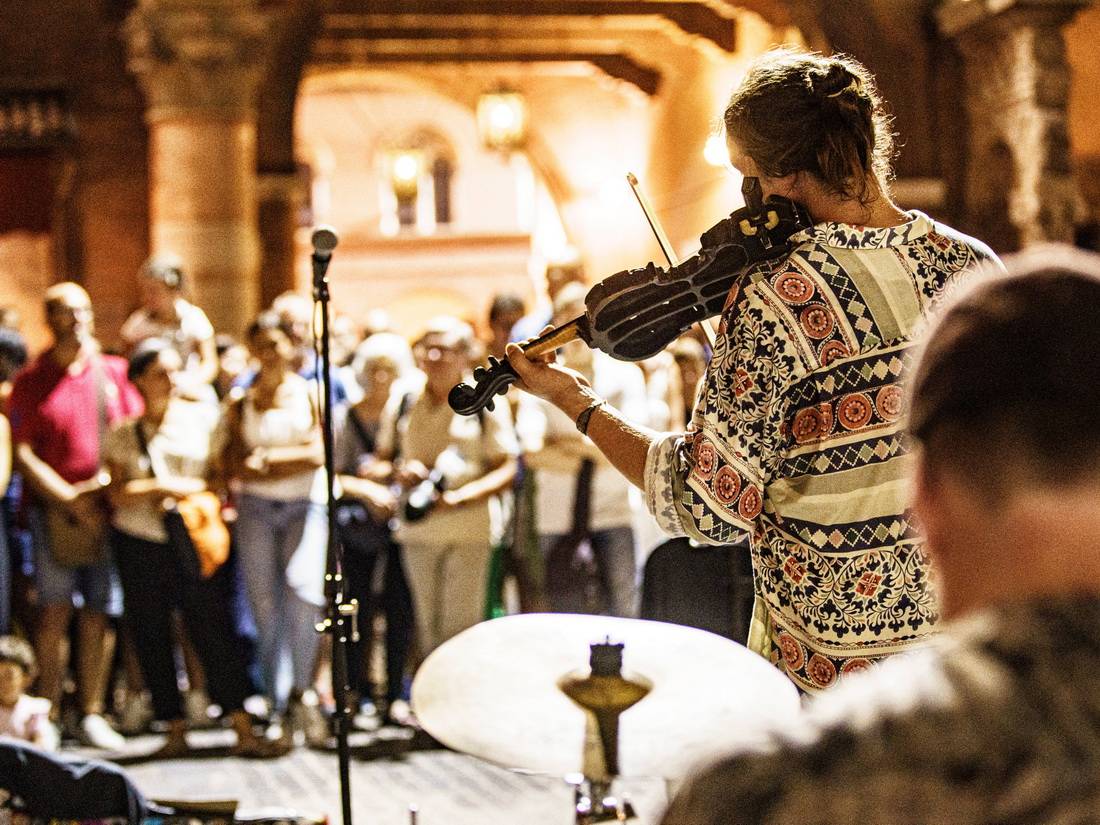
Ferrara Buskers Festival — over 250 musicians from across the world turn the city into one big stage.
Ferrara doesn’t just rest on its Renaissance walls — it also knows how to celebrate with festivals that transform the city. In late May and June, the city comes alive with the Palio di Ferrara, Italy’s oldest horse race, documented since 1259 (with medieval roots the city still debates). Expect parades, flag-throwers, and Renaissance costumes filling the main square — history turned into street theater.
In August, the Ferrara Buskers Festival brings 250+ artists from around the world and 60+ shows each evening — guitars, drums, singers, acrobats — the kind of atmosphere where you follow the music around every corner.
Both events are noisy, lively, and completely different from Ferrara’s usual calm. That contrast is what makes them unforgettable.
How many days do you need in Ferrara, Italy?
Give it at least two full days — enough to see the castle, wander the streets, eat well, and not rush. I stayed seven nights and used Ferrara as a base. Two days were for the city itself — one when I arrived, one before I left. The rest of the time I took trains: to Venice for Carnival, to Bologna, Florence, and even Rome. High-speed trains make this surprisingly doable. Rome in a day isn’t ideal, of course — more like a teaser than a visit.
I also thought about Padua or the little fishing town of Comacchio, but rain was in the forecast, so I stayed put. That turned out to be the right call: I finally took my time with the castle, and there just happened to be a chocolate festival near the cathedral. Sometimes not moving pays off.
Where to stay in Ferrara, Italy?
Anywhere in the historic centre works well, but the area around the castle and the cathedral is especially convenient. You’ll find everything you need within a few blocks — cafés, restaurants, supermarkets, and more than one good espresso. It’s flat, quiet at night, and easy to navigate even if your sense of direction is terrible.
Both hotels and apartments are easy to find. I stayed near the castle and had no regrets — close enough to everything, but not in a tourist bubble (because Ferrara doesn’t really have one).
Here are some of the best-rated places to stay — from a countryside villa to simple hostels.
Luxury stay near Ferrara
Casaforte La Bastide— A Tuscan-style villa with garden and small vineyard, about a 10-minute drive from Ferrara. The interiors feel almost castle-like, lovingly restored with plenty of historic detail (yes, even a glass-bottom floor in one suite). Breakfast is homemade and generous — people still talk about the apple pastries they missed. Rooms usually start from around €250 per night.
Mid-range hotels in Ferrara
Hotel Annunziata — If you want the perfect location, this is it: right in front of the Estense Castle. Rooms are modern and quiet, staff are famously kind, and breakfast goes way beyond a croissant. They even lend you bikes, which feels very Ferrara. Double rooms from about €100.
Dimora al Saraceno — A guesthouse in a historic building just eight minutes from the cathedral, with quiet rooms and soundproofing that actually works. Guests praise the spotless interiors, balconies with city views, and the host Francesco, who’s known for his warm welcome and great restaurant tips. Rooms usually start from around €100 per night.
Il Bagattino — A cosy B&B just steps from Ferrara Cathedral, with rooms that feel authentically Italian — clean, comfortable, and full of character. Guests praise the welcoming hosts and the restaurant right downstairs, which many call a highlight of their stay. Expect to pay from €105 per night.
Budget stays in Ferrara
Al Castello — A small guesthouse right next to the Estense Castle, with only six rooms and a homely feel. Guests praise the warm welcome — coffee, cold water on hot days, and plenty of local tips. Rooms are simple but comfortable, and the location couldn’t be better for exploring on foot. Double rooms from about €70.
Boutique Rooms 3.0 — A modern guesthouse tucked into a historic lane, just steps from Via delle Volte and minutes from the cathedral. Only six rooms, spacious and well equipped, with thoughtful touches like complimentary tea and wine in the common area. Guests love the quiet patio and the warm welcome from the hosts. Prices start around €66.
Le stanze di LaVi — A guesthouse close to the Diamanti Palace and a short walk from the station. Rooms are clean, spacious, and air-conditioned, with private bathrooms and simple modern decor. Guests like the quiet balconies and the location for exploring Ferrara on foot. Expect to pay from €65 per night.
La Chance — A small guesthouse about a 15-minute walk from Ferrara’s station, with big, clean rooms and private balconies. Guests praise the kindness of the owners and often mention the nearby trattoria Don Abbondio (literally 30 metres away) for excellent dinners. Slightly outside the centre, but close to a bus stop, so getting around isn’t a problem. Rooms are usually €60–65.
Hostel in Ferrara
Student’s Hostel Estense — Hostels in Ferrara are rare, and this one is pretty much the only budget option. Expect big dorm rooms (3–6 beds), a basic but sweet-heavy breakfast, and lockers by the beds. No kitchen for self-catering. Beds usually start from €26 per night, breakfast included.
Where to eat in Ferrara?
Eating out in Ferrara, Italy is easy and affordable — from classic trattorias to modern cafés.
I split my meals between restaurants and my apartment — I like my greens, and Ferrara makes that easy. Even small supermarkets had a solid selection: fresh produce, local cheeses, and surprisingly good ready-made dishes. You’ll find Coop, Conad, Interspar, and a few local chains scattered around the center — all within walking distance.
I bought lentil soup, minestrone, roasted pumpkin, braised artichokes and fennel, risotto — all tasty, all around €2 to €4 per portion. Local markets had all kinds of salad greens, plus plenty of fruit stalls around the city, some open well into the evening.
If cooking isn’t your thing, don’t worry — restaurants are everywhere, prices are reasonable, and the food is reliably good.
Ferrara’s Local Specialties
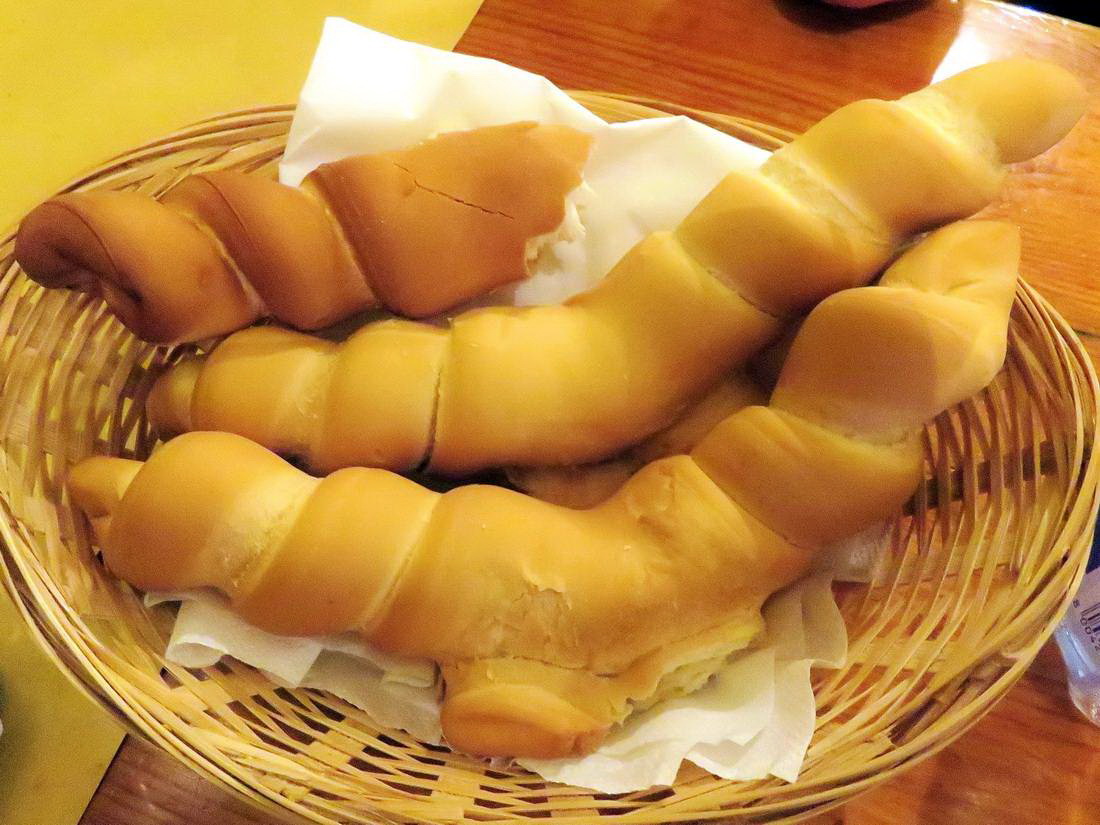
Coppia ferrarese — Ferrara’s signature twisted bread, crunchy and impossible to mistake for anything else.
The easiest way to spot Ferrara on a dinner table? Coppia ferrarese — so iconic it has UNESCO heritage status. It’s served everywhere, from trattorias to bakeries, and once you’ve seen its shape, you won’t confuse it with anything else.
Another local star is cappellacci di zucca, pumpkin-filled pasta usually served with butter and sage or a rich ragù. If you like stronger flavors, try salama da sugo, a slow-cooked, wine-infused sausage that locals eat with mashed potatoes.
And if you’re here in winter, look for pampepato — a dense chocolate-and-spice cake that tastes like Ferrara in December.
If you’re curious to cook at home, here’s a recipe for cappellacci di zucca.
Coffee is refreshingly affordable: espresso goes for €1.30–1.50, cappuccino for €2–2.50. A decent bottle of wine from the store starts at €4.
How to get to Ferrara?
The good news: Ferrara is easy to reach, no matter how you arrive in northern Italy.
By air. The closest airport is Bologna (BLQ). From there it’s a quick hop on the Marconi Express monorail to Bologna Centrale (about seven minutes) and then a regional train to Ferrara. All in, you’ll be in town within an hour. Venice Marco Polo (VCE) has more international flights, with trains to Ferrara taking roughly 1½–2 hours depending on connections. I flew into Treviso (TSF) once — a tiny low-cost airport where baggage claim feels like someone’s garage. From there it was a quick bus to the train station and then on to Ferrara.
By train. Rail is the easiest way to arrive. Bologna is the quickest hop — 30 to 40 minutes on regional trains that run all day. Venice or Padua take around an hour to an hour and a half. Rome is connected by direct high-speed trains, about three and a half to four hours. Florence is trickier: there’s no direct line, so you change in Bologna. Tickets and schedules are on Trenitalia or Italo. You can also check and book via Omio
— handy if you prefer English booking and want to compare all routes in one place.
From the station. Ferrara’s station is about 1.5 km from the centre. It’s a flat 15–20 minute walk to the Estense Castle, or a quick 5–10 minutes by TPER city bus if your suitcase — or your Parmesan stash — is too heavy.
How to pay for the bus?
Just tap your bank card/phone on the green validator when you board — single urban fare is €2.30, valid 75 minutes. The system automatically gives you the best price if you make several trips in a day. Paper tickets at tabaccherie cost roughly the same; drivers don’t sell tickets.
Do people in Ferrara speak English?
In Ferrara you won’t find the same level of English you hear in bigger tourist cities like Florence or Venice. In hotels, museums, and main restaurants staff usually speak decent English. Younger people and students often do too.
In small shops, markets, or with older locals you might run into some language gaps. For example, at a tabaccheria where I bought postage stamps they barely understood me — but gestures did the job just fine. A smile, a bit of Google Translate, or a few words of Italian (“un caffè, per favore”) go a long way here.
The good news is that Ferrara isn’t overrun with tourists, so people are generally patient and friendly. Even if conversations switch to gestures, you’ll rarely feel unwelcome.
Where to go from Ferrara?
One of the perks of Ferrara is how easy it is to get almost anywhere. I took direct trains to Venice, Rome, Florence, and Bologna — all without much fuss. For Rome and Florence, I booked high-speed train tickets in advance (prices creep up the closer you get to the date). Trains to Venice and Bologna run hourly and are always the same price, unless you go fancy with the fast ones.
Regional trips (Bologna, Venice, Padua) are a flat price and can be bought at the station — or online via Trenitalia. For English booking and easy comparisons, you can also use Omio.
Venice. I went for the Carnival and spent nine hours in the city — just enough to soak it in without feeling crushed. The trip itself was smooth and surprisingly relaxed, considering the event.
Rome. I saw a few iconic sights, but let’s be honest — one day is a teaser, not a visit. Still, worth it. I’ll be back.
Florence. I lived there for over a week a few years ago, so this visit was pure nostalgia — a slow walk through familiar streets and, inevitably, five tiny pasticcini. They were delicate, coin-sized pastries I definitely didn’t need, but I ate them anyway.
Bologna. Just a short ride away and full of arcades, towers, and corners that pull you in. I wandered aimlessly and ended up in the Archiginnasio Library — an old university building with centuries-old books, faded crests, and a reading room that smells like ink and history. Quietly spectacular.
I hadn’t planned to see so much — but Ferrara made it easy. And there were still places I didn’t get to: Padua, Ravenna, Modena, Parma, even Comacchio with its fishing boats and canals. All within reach, all waiting for next time.
Ferrara Travel FAQ
Quick answers to the most common questions about Ferrara — a recap if you don’t want to scroll back through the whole guide.
Is Ferrara worth visiting?
Yes — it’s a UNESCO-listed Renaissance city with a moated castle, quiet piazzas and far fewer tourists than Florence or Venice.
How many days in Ferrara?
At least 2 days to see the main sights. Many travellers use Ferrara as a base for day trips to Bologna, Venice or Florence.
Is Ferrara walkable?
Yes — the historic centre is flat and compact. Most landmarks are within a 15–20 minute walk.
What food is Ferrara famous for?
Coppia ferrarese bread, cappellacci di zucca (pumpkin pasta), salama da sugo sausage, and the spiced chocolate cake pampepato.
What is the weather like in Ferrara?
Summers are hot and humid (up to 33°C), winters are damp and foggy, while spring and autumn bring mild weather but frequent rain.
Marking Your Spot
Ferrara gets on with its life, and you just happen to be there. Nothing feels staged, nothing feels rushed.
It’s a city of small details. A chocolate fair that appears out of nowhere. Mirrors in a castle angled for lazy necks. Stone lions that don’t bother to look impressed.
And a seller of tiny succulents by the old castle — three euros each, lined up in plastic pots, stubbornly alive. I still regret not picking up a couple.
Markets stacked with greens, artichokes, roasted pumpkin, and more kinds of salad than anyone really needs. That’s Ferrara.
And yes — I miss it.
